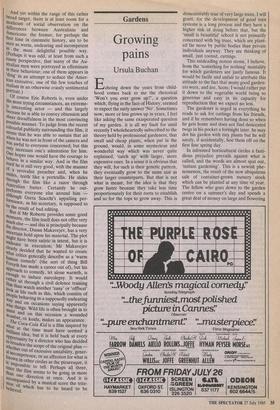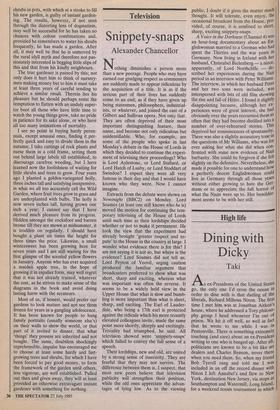Gardens
Growing pains
Ursula Buchan
Echoing down the years from child- hood comes back to me the rhetorical 'Won't you ever grow up?', a question which, flying in the face of History, seemed to expect the surly answer 'No'. Sometimes now, more or less grown up in years, I feel like asking the same exasperated question of my garden. it is all my fault for until recently I wholeheartedly subscribed to the theory held by professional gardeners, that small and cheap plants, when put in the ground, would, in some mysterious and wonderful way which was never quite explained, 'catch up' with larger, more expensive ones. In a sense it is obvious that they will, for such is their genetic pattern, they eventually grow to the same size as their larger counterparts. But that is not what is meant, for the idea is that they grow faster because they take less time proportionately for their roots to establish and so for the tops to grow away. This is demonstrably true of very large trees, I will grant, for the development of good root systems is a long process and they have a higher risk of dying before that, but the 'small is beautiful' school is not primarily concerned with big trees, which are plant- ed far more by public bodies than private individuals anyway. They are thinking of small, just rooted, cuttings.
This misleading notion stems, I believe, from the 'something for nothing' mentality for which gardeners are justly famous. It would be facile and unfair to attribute this attitude to the fact that many good garden- ers were, and are, Scots; I would rather put it down to the vegetable world being so generous and easy in its capacity for reproduction that we expect no less.
The gardener is urged in everything he reads to ask for cuttings from his friends, and if he remembers having done so when he gets home and does not find desiccated twigs in his pocket a fortnight later, he may dot his garden with tiny plants but he will surely, if accidentally, hoe them off on the first fine spring day.
In informed horticultural circles a fasti- dious prejudice prevails against what is called, and the words are almost spat out, 'instant gardening'. This is a newish phe- nomenon, the result of the now ubiquitous sale of container-grown nursery stock which can be planted at any time of year. The fellow who goes down to the garden centre on a summer's day and spends a great deal of money on large and flowering shrubs in pots, with which at a stroke to fill his new garden, is guilty of instant garden- ing. The results, however, if not seen through the distorting lens of dogmatism, may well be successful for he has taken no chances with colour combinations and, provided he remembers to water his shrubs frequently, he has made a garden. After all, it may well be that he is unmoved by the rural idyll myth and therefore not pas- sionately interested in begging little slips of this and that from his kindly neighbours.
The true gardener is pained by this; not only does it hurt him to think of nursery- men making money but to him it must take at least three years of careful tending to achieve a similar result. Therein lies his pleasure but he should perhaps resist the temptation to flatten with an unduly super- ior boot all those who have little time to watch the young things grow, take no pride in patience for its sake alone, or who have all too many intimations of mortality.
I see no point in buying hardy peren- nials, except unusual ones, finding it per- fectly quick and easy to divide them in the autumn; I take cuttings of rock plants and nurse them in a cold frame, setting them out behind large labels till established, to discourage carefree weeding, but I have learned now the foolishness of waiting for little shrubs and trees to grow. Four years ago I planted a golden-variegated holly, three inches tall and satisfying inexpensive, in what we all too accurately call the Wild Garden, where fruit trees grow in grass and are underplanted with bulbs. The holly is now seven inches tall, having grown one inch a year; I cannot say that I have derived much pleasure from its progress. Hidden amongst the cocksfoot and barren brome till they are mown at midsummer, it is trodden on regularly. I should have bought a plant six times the height for three times the price. Likewise, a small wintersweet has been growing here for seven years and I am still waiting for the first glimpse of the scented yellow flowers in January. Anyone who has ever acquired a maiden apple tree, in the hope of growing it in espalier form, may well regret that it was not already trained, whatever the cost, as he strives to make sense of the diagrams in the book and avoid doing lasting harm with the secateurs.
Most of us, if honest, would prefer our gardens to look mature and not see them frozen for years in a gangling adolescence. It has been known for people to hang family portraits (usually someone else's) on their walls to show the world, or that part of it invited to dinner, that what `things' they possess are inherited and not bought. The same, doubtless shockingly reprehensible, impulse has encouraged me to choose at least some hardy and fast- growing trees and shrubs, for which I have been forced to pay good money, to form the framework of the garden until others, less vigorous, are well established. Pulled Out then and given away, they will at least provided an otherwise extravagant instant gardener with something for nothing.















































 Previous page
Previous page